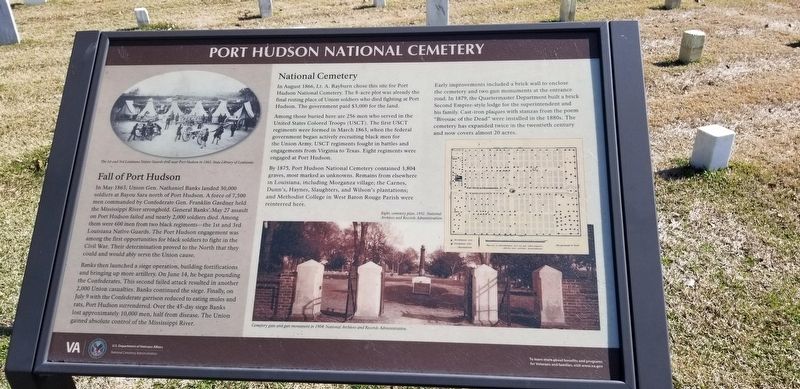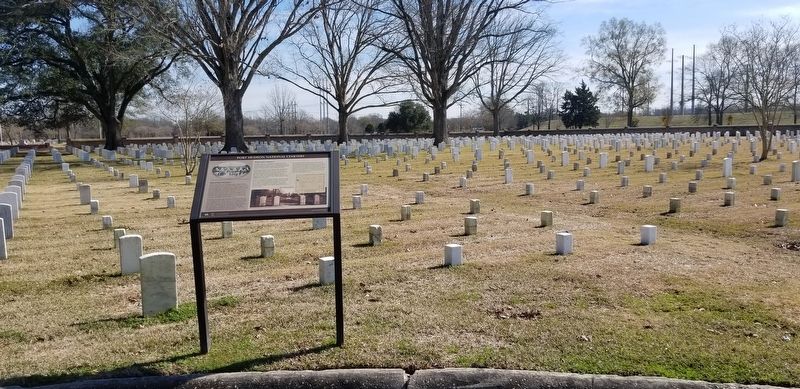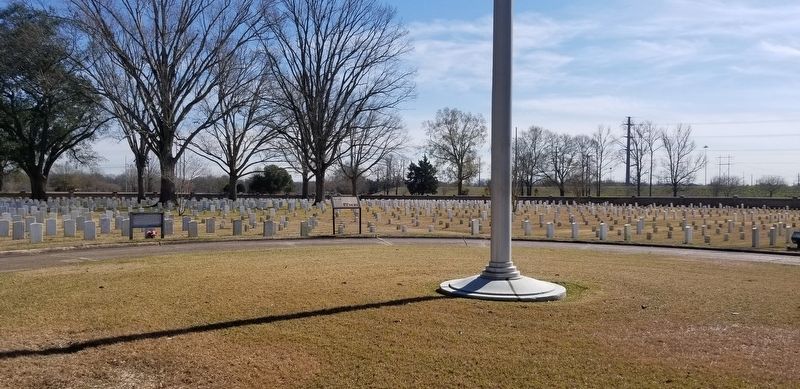Port Hudson National Cemetery
Fall of Port Hudson
In May 1863, Union Gen. Nathaniel Banks landed 30,000 soldiers at Bayou Sara north of Port Hudson. A force of 7,500 men commanded by Confederate Gen. Franklin Gardner held the Mississippi River stronghold. General Banks' May 27 assault on Port Hudson failed and nearly 2,000 soldiers died. Among them were 600 men from two black regiments—the 1st and 3rd Louisiana Native Guards. The Port Hudson engagement was among the first opportunities for black soldiers to fight in the Civil War. Their determination proved to the North that they could and would ably serve the Union cause.
National Cemetery
In August 1866, Lt. A. Rayburn chose this site for Port
Hudson National Cemetery. The 8-acre plot was already the
final resting place of Union soldiers who died fighting at Port
Hudson. The government paid $3,000
Among those buried here are 256 men who served in the United States Colored Troops (USCT). The first USCT regiments were formed in March 1863, when the federal government began actively recruiting black men for the Union Army. USCT regiments fought in battles and engagements from Virginia to Texas. Eight regiments were engaged at Port Hudson.
By 1875, Port Hudson National Cemetery contained 3,804 graves, most marked as unknowns. Remains from elsewhere in Louisiana, including Morganza village; the Carnes Dunn''s, Haynes, Slaughters, and Wilson''s plantations; and Methodist College in West Baton Rouge Parish were reinterred here.
Early improvements included a brick wall to enclose
the cemetery and two gun monuments at the entrance
road. In 1879, the Quartermaster Department built a brick
Second Empire-style lodge for the superintendent and
his family. Cast-iron plaques with stanzas from the poem
"Bivouac of the Dead” were installed in the 1880s. The
cemetery has expanded twice in the twentieth century
and now covers almost 20 acres.
Erected by US Department of Veterans Affairs, National Cemetery Administration.
Topics and series. This historical marker is listed in these topic lists: Cemeteries & Burial Sites • Military
Location. 30° 39.65′ N, 91° 16.482′ W. Marker is in Zachary, Louisiana, in East Baton Rouge Parish. Marker is at the intersection of Port Hudson Cemetery Road (State Highway 3113) and Port Hickey Road, on the right when traveling west on Port Hudson Cemetery Road. Touch for map. Marker is at or near this postal address: 20978 Port Hickey Road, Zachary LA 70791, United States of America. Touch for directions.
Other nearby markers. At least 8 other markers are within 2 miles of this marker, measured as the crow flies. Medal of Honor Tree (within shouting distance of this marker); A National Cemetery System (about 400 feet away, measured in a direct line); Heroes Of The War On Terrorism (about 400 feet away); Purple Heart Memorial (about 800 feet away); Commissary Hill (approx. 1.8 miles away); Lower Commissary Hill Battery (approx. 1.8 miles away); Steedman Headquarters (approx. 1.9 miles away); Subterranean Torpedoes (approx. 1.9 miles away). Touch for a list and map of all markers in Zachary.
More about this marker. Marker is located on cemetery grounds, in the circle at center flag pole.
Credits. This page was last revised on January 27, 2019. It was originally submitted on January 27, 2019, by Cajun Scrambler of Assumption, Louisiana. This page has been viewed 291 times since then and 45 times this year. Photos: 1, 2, 3. submitted on January 27, 2019.


